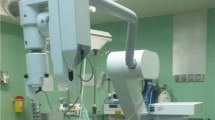Abstract
In this study, the detailed characteristics, including spatial uniformity, dose distributions, inter-batch variability, reproducibility, and long-term temporal stability, of N-isopropylacrylamide (NIPAM) polymer gel dosimeter were investigated. A commercial 10x fast optical computed tomography scanner (OCTOPUSTM-10×, MGS Research, Inc., Madison, CT, USA) was used to measure NIPAM polymer gel dosimeter. A cylindrical NIPAM gel phantom that measured 10 cm × 10 cm was irradiated via a single-field treatment plan with a field size of 4 cm × 4 cm. The maximum standard deviation of spatial uniformity for NIPAM gel was less than 0.29 %. The average standard deviation among the three batches of gel dosimeters was less than 1 %. The gamma pass rate could reach as high as 96.76 % when a 3 % dose difference and a 3 mm dose-to-agreement criteria were used. The long-term measurement of irradiated NIPAM gel dosimeter indicated that the dose maps attained a gradually stable value 15 h post-irradiation and remained stable until 72 h post-irradiation. The gamma pass rate could achieve a maximum value between 24 and 72 h post-irradiation. The edge enhancement effect that occurred around the irradiated region was observed 72 h post-irradiation. Thus, the results from this study suggest that NIPAM gel dosimeter should be measured approximately 24 h post-irradiation to reduce the occurrence of the edge enhancement effect.











Similar content being viewed by others
References
Baldock C, De Deene Y, Doran S, Ibbott G, Jirasek A, Lepage M, McAuley KB, Oldham M, Schreine LJ (2010) Polymer gel dosimetry. Phys Med Biol 55:R1–R63
Oldham M, Siewerdsen JH, Kumar S, Wong J, Jaffray DA (2003) Optical-CT gel dosimetry I: basic investigations. Med Phys 30:623–634
Venning AJ, Nitschke KN, Keall PJ, Baldock C (2003) Radiological properties of normoxic polymer gel dosimeters. Med Phys 32(4):1047–1053
Gorjiara T, Hill R, Bosi S, Kuncic Z, Baldock C (2013) Water equivalence of NIPAM based polymer gel dosimeters with enhanced sensitivity for X-ray CT. Radiat Phys Chem 91:60–69
Senden RJ, Jean PD, McAuley KB, Schreiner LJ (2006) Polymer gel dosimeters with reduced toxicity: a preliminary investigation of the NMR and optical dose - response using different monomers. Phys Med Biol 51:3301–3314
Jirasek A, Hilts M, Shaw C, Baxter P (2006) Investigation of tetrakis hydroxymethyl phosphonium chloride as an antioxidant for use in X-ray computed tomography polyacrylamide gel dosimetry. Phys Med Biol 51:1891–1906
Koeva VI, Csaszar ES, Senden RJ, McAuley KB, Schreiner LJ (2008) Polymer gel dosimeters with increased solubility: a preliminary investigation of the NMR and optical dose–response using different crosslinkers and co-solvents. Macromol Symp 261:157–166
Chang YJ, Hsieh BT, Liang JA (2011) A systematic approach to determine optimal composition of gel used in radiation therapy. Nucl Instrum Methods Phys Res Sect A 652:783–785
Hsieh BT, Chang YJ, Han RP, Wu J, Hsieh LL, Chang CJ (2011) A study on dose response of NIPAM-based dosimeter used in radiotherapy. J Radioanal Nucl Chem 290:141–148
Chang YJ, Hsieh BT (2012) Effect of composition interactions on the dose response of an N-isopropylacrylamide gel dosimeter. PLoS ONE 7:1–8
De Deene Y, Pittomvils G, Visalatchi S (2007) The influence of cooling rate on the accuracy of normoxic polymer gel dosimeters. Phys Med Biol 52:2719–2728
Hsieh BT, Wu J, Chang YJ (2013) Verification on dose Profile variation of 3D polymer gel dosimeter. IEEE Trans Nucl Sci 60:560–565
Dumas EM, Leclerc G, Lepage M (2006) Effect of container size on the accuracy of polymer gel dosimetry. J Phys Conf Ser 56:239–241
Sedaghat M, Hubert-Tremblay V, Tremblay L, Bujold R, Lepage M (2009) Volume-dependent internal temperature increase within polymer gel dosimeters during irradiation. J Phys Conf Ser 164:1–5
Low DA, Harms WB, Mutic S, Purdy JA (1998) A technique for the quantitative evaluation of dose distributions. Med Phys 25:656–661
Xu Y, Wuu CS (2013) Optical computed tomography utilizing a rotating mirror and Fresnel lenses. Phys Med Biol 58:479–495
Gore JC, Ranade M, Maryanski MJ, Schulz RJ (1996) Radiation dose distributions in three dimensions from tomographic optical density scanning of polymer gels: I. development of an optical scanner. Phys Med Biol 41:2695–2704
Xu Y, Wuu CS (2004) Performance of a commercial optical-CT scanner and polymer gel dosimeters for 3D dose verification. Med Phys 31:3024–3033
Xu Y, Wuu CS, Maryanski MJ (2010) Sensitivity calibration procedures in optical-CT scanning of BANG 3 polymer gel dosimeters. Med Phys 37:861–868
Vandecasteele J, De Deene Y (2013) On the validity of 3D polymer gel dosimetry: I. Reproducibility study. Phys Med Biol 58:19–42
Low DA, Morele P, Chow P, Dou TH, Ju T (2013) Does the γ dose distribution comparison technique default to the distance to agreement test in clinical dose distributions. Med Phys 40(7):656–661
McAuley KB (2004) The chemistry and physics of polyacrylamide gel dosimeters: why they do and don’t work. J Phys Conf Ser 3:29. doi:10.1088/1742-6596/3/1/005
Chain JNM, Schreiner LJ, McAuley KB (2010) Mathematical modelling of depth-dose response of polymer gel dosimeters. J Phys Conf Ser 250:012065. doi:10.1088/1742-6596/250/1/012065
Massillon-JL G, Minniti R, Soares CG, Maryanski MJ, Robertson S (2010) Characteristics of a new polymer gel for high-dose gradient dosimetry using a micro optical CT scanner. Appl Radiat Isot 68:144–154
Acknowledgments
The authors would like to thank the National Science Council of the Republic of China for financially supporting this research under Grant Nos. NSC 102-2314-B-166-003-, NSC 101-2314-B-166-005-, and NSC 99-2632-B-166-001-MY3.
Author information
Authors and Affiliations
Corresponding author
Rights and permissions
About this article
Cite this article
Chang, Y.J., Chen, C.H. & Hsieh, B.T. Characterization of long-term dose stability of N-isopropylacrylamide polymer gel dosimetry. J Radioanal Nucl Chem 301, 765–780 (2014). https://doi.org/10.1007/s10967-014-3231-x
Received:
Published:
Issue Date:
DOI: https://doi.org/10.1007/s10967-014-3231-x




